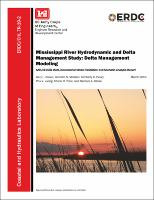Please use this identifier to cite or link to this item:
https://hdl.handle.net/11681/32446| Title: | Mississippi River Hydrodynamic and Delta Management Study : Delta Management modeling : AdH/SEDLIB multi-dimensional model validation and scenario analysis report |
| Authors: | Brown, Gary L. McAlpin, Jennifer N. Pevey, Kimberly C. Luong, Phu V. Price, Cherie R. Kleiss, Barbara A., 1958- |
| Keywords: | Geomorphology Hydrodynamic--Models River engineering--Mississippi River Delta (La.) Deltas Salinity Reserve (La.) Mexico, Gulf of Sediment transport Wetland hydrology Wetlands |
| Publisher: | Coastal and Hydraulics Laboratory (U.S.) Engineer Research and Development Center (U.S.) |
| Series/Report no.: | Technical Report (Engineer Research and Development Center (U.S.)) ; no. ERDC/CHL TR-19-2 |
| Abstract: | This report details the process of developing and validating a multi-dimensional hydrodynamic, salinity, sediment transport, and coastal wetland morphology model of the Lower Mississippi River Delta. This model has been developed to run various sediment diversion scenarios. The results of these scenario analyses are documented in this report. The morphologic modeling results for the diversion scenario analyses show net land gain in the near vicinity of the diversion outlets and net land loss farther away from the outlets. The areas of land gain roughly correspond with the zones of sand deposition whereas the areas of largest land loss correspond with areas where there is diversion-induced inundation but not significant deposition of sediment from the diversion. The modeling results indicate that diversion-induced inundation results in a reduction in plant productivity, which induces an acceleration of land loss. Significant uncertainty exists with respect to the response of the existing wetland vegetation to diversion-induced inundation. The magnitude of this uncertainty can only be narrowed with further consensus building within wetland science. With respect to salinity, the receiving waters tend to freshen significantly during diversion operations. However, when operations cease, the recovery of salinity is almost entirely determined by prevailing offshore and/or riverine conditions. |
| Description: | Technical Report |
| Gov't Doc #: | ERDC/CHL TR-19-2 |
| Rights: | Approved for Public Release; Distribution is Unlimited |
| URI: | https://hdl.handle.net/11681/32446 http://dx.doi.org/10.21079/11681/32446 |
| Appears in Collections: | Technical Report |
Files in This Item:
| File | Description | Size | Format | |
|---|---|---|---|---|
| ERDC-CHL TR-19-2.pdf | 42.8 MB | Adobe PDF |  View/Open |